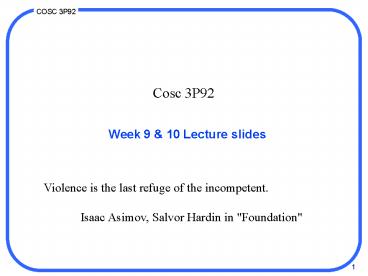Week 9 - PowerPoint PPT Presentation
Title: Week 9
1
Cosc 3P92
- Week 9 10 Lecture slides
Violence is the last refuge of the incompetent.
Isaac Asimov, Salvor Hardin in "Foundation"
2
Virtual Memory
- The main idea is to allow programs to address
more memory locations than are physically
available. - first overlays programmer manually divide
programs into sections, and read, write them
out during execution. - virtual memory automatic transparent overly
mgmt - virtual (logical) address generated by program
physical address actual memory address during
execution - Addresses generated by programs are called
virtual addresses, and which are mapped into
physical addresses during execution time.
3
Virtual Memory
- Three techniques
- paging system
- segmentation system
- paged segmentation system
4
Virtual Memory Paging
Paging system The virtual address space is
divided into equal-sized pages and the physical
memory is divided into frames of the same size.
- IF PageTablepage . residence-bit 1 THEN
- RETURN Frame PageTablepage .frame offset
- ELSE
- page fault
5
Example
6
Paging
page mapping mechanism is often done via
special hardware page fault page not
resident - read from secondary storage into
main memory - update page table with
physical memory address - repeat
instruction that caused fault demand paging
get page only when asked for vs. algorithms
which evaluate page usage and do predictive
page fetches working set the finite set
of pages which a program will use during
execution (ie. progrms don't use infinite
memory) when working set size gt page
frames, thrashing likely
7
Paging
- Page replacement
- random (not recommended)
- least recently used
- first-in-first-out (least recently paged in)
- can use dirty bits write back pages only when
modified - fragmentation page sizes fixed, so can have
unused page portions (and therefore unused
memory)
8
Paging
- Large page sizes
- maximal use of slow secondary storage
- less frequent page reads
- smaller tables
- more apt to have fragmentation
- Small page sizes
- less fragmentation
- good for programs that use small spread out
memory references - need more IO calls, larger tables
9
Virtual Memory Segmentation
- Segmentation system A program is divided into a
collection of logical segments (e.g., procedures,
arrays, stacks) which may be of different sizes.
Each segment has a separate virtual address space.
Virtual Memory
0
segment A
segment B
1
2
segment C
- IF SegmentTableseg .valid-bit 1 THEN
- IF offset lt SegmentTableseg .length THEN
- RETURN SegmentTableseg .base offset
- ELSE
- memory violation
- ELSE
- segment fault
segment D
3
10
Segmentation
- Segments can be allocated for different program
parts, data structures, users - Different modes, access privileges can be
assigned - (permits memory violation checking, shared
memory,...) - Sizes are alterable during execution.
- The basis for multitasking multi-user systems
11
Segmentation
- Garbage collection best fit, first-fit, hole
compaction, ...
12
Paged segmentation system
- Merges ideas of previous 2 approaches
- Segments are divided into groups of pages
- Virtual address is a triple lts,p,dgt
- e.g MULTICS
13
Paged segmentation
- Address mapping
- 1. segment numbers leads to index in segment
table - gives base address of page table
- 2. page no. p indexed into page table, and frame
p' is found - 3. physical address computed by adding
displacement d to p' - Speeding up virtual memory access
- address translation look aside buffer
- like a page table cache
- associative memory contains most recently used
page info - common in mainframes
fig next page
14
(No Transcript)
15
Paged vs Segmentation
16
Example Pentium II VM support
- A paged-segmentation system
- MMU memory mgmt unit on CPU
- PII has segment registers DS (data), CS (code),
... - 6.12, 6.13, 6.14
- Scheme
- selector 16-bits, 1 per segment, loaded into
approp. segment register - local application global OS, system
- corresp. segment descriptor loaded for that
segment - offset is checked to see if it is beyong segment
bounds (TRAP - software interrupt) - seg size G 0 (seg size up to 1 Mb) G1
(pages) - base added to offset to get a linear address
(base split for back-compatibility with 286) - if paging off, this address is physical address
- if paging on --gt its a virtual address
- must be mapped page directory (1K entries) --gt
page table (1K page entries) --gt phys address
6.15
17
(No Transcript)
18
(No Transcript)
19
(No Transcript)
20
Example ultraSparc VM support
- Paged virtual memory supported
- only 44 bits of 64-bit addr space used for VM
- varying page sizes 6.17
- TLB translation lookaside buffer 6.18
- maps virtual page to physical page frame
- 64 most recently used virt. page s for each of
instns, data - also a context -- process ID
- if not in TLB, a trap called, and OS software
must fix - not same as a page miss! page may be in memory.
- OS must also maintain a TSB (trans. storage
buffer) - like a cache of pages - otherwise, if a TSB miss, then OS does whatever
it wants to implement it --gt no H/W support!
21
(No Transcript)
22
(No Transcript)
23
Comparing PII and UltraSparc
- PII
- 32-bit segments, fixed 1K segment/page table
sizes - max 1 million pages per segment
- can do pure segmentation, pure paging, or paged
segmentation - only 1 segment per process in Windows, Unix
- UltraSparc
- huge address space
- 2 billion pages conventional page tables
unworkable
24
The end































